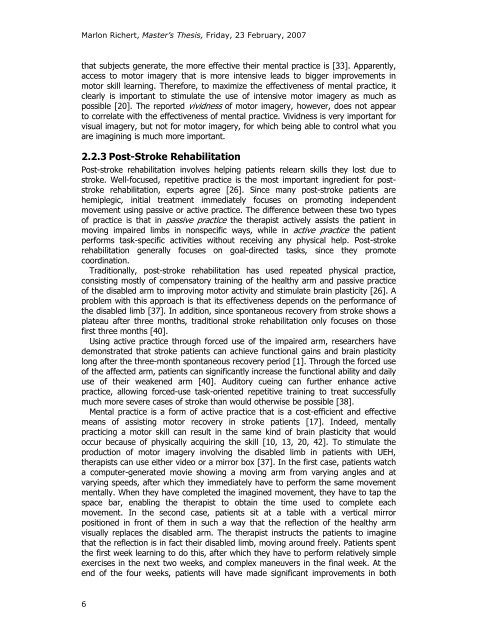The AR Workbench: A Complete Co-located Reach-in Mirror-Based ...
The AR Workbench: A Complete Co-located Reach-in Mirror-Based ...
The AR Workbench: A Complete Co-located Reach-in Mirror-Based ...
Create successful ePaper yourself
Turn your PDF publications into a flip-book with our unique Google optimized e-Paper software.
Marlon Richert, Master’s <strong>The</strong>sis, Friday, 23 February, 2007<br />
that subjects generate, the more effective their mental practice is [33]. Apparently,<br />
access to motor imagery that is more <strong>in</strong>tensive leads to bigger improvements <strong>in</strong><br />
motor skill learn<strong>in</strong>g. <strong>The</strong>refore, to maximize the effectiveness of mental practice, it<br />
clearly is important to stimulate the use of <strong>in</strong>tensive motor imagery as much as<br />
possible [20]. <strong>The</strong> reported vividness of motor imagery, however, does not appear<br />
to correlate with the effectiveness of mental practice. Vividness is very important for<br />
visual imagery, but not for motor imagery, for which be<strong>in</strong>g able to control what you<br />
are imag<strong>in</strong><strong>in</strong>g is much more important.<br />
2.2.3 Post-Stroke Rehabilitation<br />
Post-stroke rehabilitation <strong>in</strong>volves help<strong>in</strong>g patients relearn skills they lost due to<br />
stroke. Well-focused, repetitive practice is the most important <strong>in</strong>gredient for poststroke<br />
rehabilitation, experts agree [26]. S<strong>in</strong>ce many post-stroke patients are<br />
hemiplegic, <strong>in</strong>itial treatment immediately focuses on promot<strong>in</strong>g <strong>in</strong>dependent<br />
movement us<strong>in</strong>g passive or active practice. <strong>The</strong> difference between these two types<br />
of practice is that <strong>in</strong> passive practice the therapist actively assists the patient <strong>in</strong><br />
mov<strong>in</strong>g impaired limbs <strong>in</strong> nonspecific ways, while <strong>in</strong> active practice the patient<br />
performs task-specific activities without receiv<strong>in</strong>g any physical help. Post-stroke<br />
rehabilitation generally focuses on goal-directed tasks, s<strong>in</strong>ce they promote<br />
coord<strong>in</strong>ation.<br />
Traditionally, post-stroke rehabilitation has used repeated physical practice,<br />
consist<strong>in</strong>g mostly of compensatory tra<strong>in</strong><strong>in</strong>g of the healthy arm and passive practice<br />
of the disabled arm to improv<strong>in</strong>g motor activity and stimulate bra<strong>in</strong> plasticity [26]. A<br />
problem with this approach is that its effectiveness depends on the performance of<br />
the disabled limb [37]. In addition, s<strong>in</strong>ce spontaneous recovery from stroke shows a<br />
plateau after three months, traditional stroke rehabilitation only focuses on those<br />
first three months [40].<br />
Us<strong>in</strong>g active practice through forced use of the impaired arm, researchers have<br />
demonstrated that stroke patients can achieve functional ga<strong>in</strong>s and bra<strong>in</strong> plasticity<br />
long after the three-month spontaneous recovery period [1]. Through the forced use<br />
of the affected arm, patients can significantly <strong>in</strong>crease the functional ability and daily<br />
use of their weakened arm [40]. Auditory cue<strong>in</strong>g can further enhance active<br />
practice, allow<strong>in</strong>g forced-use task-oriented repetitive tra<strong>in</strong><strong>in</strong>g to treat successfully<br />
much more severe cases of stroke than would otherwise be possible [38].<br />
Mental practice is a form of active practice that is a cost-efficient and effective<br />
means of assist<strong>in</strong>g motor recovery <strong>in</strong> stroke patients [17]. Indeed, mentally<br />
practic<strong>in</strong>g a motor skill can result <strong>in</strong> the same k<strong>in</strong>d of bra<strong>in</strong> plasticity that would<br />
occur because of physically acquir<strong>in</strong>g the skill [10, 13, 20, 42]. To stimulate the<br />
production of motor imagery <strong>in</strong>volv<strong>in</strong>g the disabled limb <strong>in</strong> patients with UEH,<br />
therapists can use either video or a mirror box [37]. In the first case, patients watch<br />
a computer-generated movie show<strong>in</strong>g a mov<strong>in</strong>g arm from vary<strong>in</strong>g angles and at<br />
vary<strong>in</strong>g speeds, after which they immediately have to perform the same movement<br />
mentally. When they have completed the imag<strong>in</strong>ed movement, they have to tap the<br />
space bar, enabl<strong>in</strong>g the therapist to obta<strong>in</strong> the time used to complete each<br />
movement. In the second case, patients sit at a table with a vertical mirror<br />
positioned <strong>in</strong> front of them <strong>in</strong> such a way that the reflection of the healthy arm<br />
visually replaces the disabled arm. <strong>The</strong> therapist <strong>in</strong>structs the patients to imag<strong>in</strong>e<br />
that the reflection is <strong>in</strong> fact their disabled limb, mov<strong>in</strong>g around freely. Patients spent<br />
the first week learn<strong>in</strong>g to do this, after which they have to perform relatively simple<br />
exercises <strong>in</strong> the next two weeks, and complex maneuvers <strong>in</strong> the f<strong>in</strong>al week. At the<br />
end of the four weeks, patients will have made significant improvements <strong>in</strong> both<br />
6
















